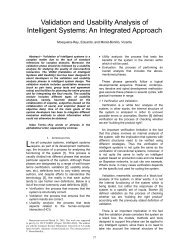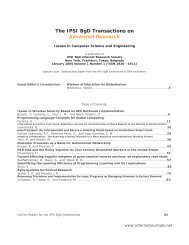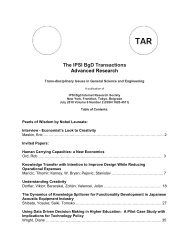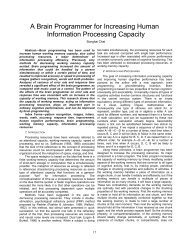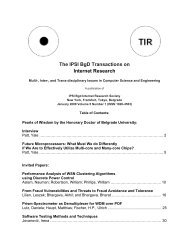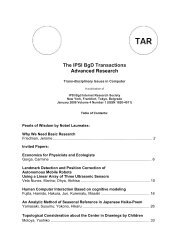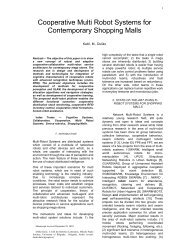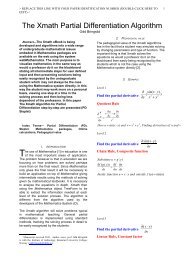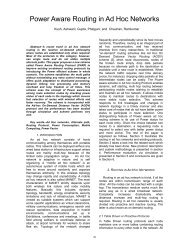The IPSI BgD Transactions on Internet Research - Welcome
The IPSI BgD Transactions on Internet Research - Welcome
The IPSI BgD Transactions on Internet Research - Welcome
Create successful ePaper yourself
Turn your PDF publications into a flip-book with our unique Google optimized e-Paper software.
egressi<strong>on</strong> demands more effort. Usually ILP<br />
systems require a complete set of examples to<br />
successfully induce recursive definiti<strong>on</strong>s.<br />
However, a complete set of examples can be<br />
expected <strong>on</strong>ly in artificial domains and not in real<br />
world domains. That is why we need to create a<br />
process that combines available examples and<br />
simulates the missing examples.<br />
In summary, 4S performs as well as other<br />
academic systems dealing with reas<strong>on</strong>able<br />
problem domains. If we compare accuracy with<br />
FORS, 4S performs similarly or even marginally<br />
better <strong>on</strong> some domains, while being more<br />
flexible and tunable to a particular domain. In<br />
comparis<strong>on</strong> with more complex systems that<br />
demand inclusi<strong>on</strong> of additi<strong>on</strong>al program code,<br />
setting parameters in 4S is far less demanding<br />
even for n<strong>on</strong>-specialized users.<br />
REFERENCES<br />
[1] A. Appice, M. Ceci, and D. Malerba. Mining model trees:<br />
A multi-relati<strong>on</strong>al approach. In T. Horvath and A.<br />
Yamamoto, editors, Inductive Logic Programming, 13th<br />
Internati<strong>on</strong>al C<strong>on</strong>ference, ILP 2003, volume 2835 of<br />
LNAI, pages 4_21. Springer-Verlag, 2003<br />
[2] Bratko, I. and Džeroski, S., “Engineering applicati<strong>on</strong>s of<br />
ILP”, New Generati<strong>on</strong> Computing 13 (pp. 313-333),<br />
1995.<br />
[3] Blockeel, H., Top-down inducti<strong>on</strong> of first order logical<br />
decisi<strong>on</strong> trees. PhD <str<strong>on</strong>g>The</str<strong>on</strong>g>sis, Katholike Universiteit,<br />
Leuven, Belgium, 1998.<br />
[4] Camacho, R., “Learning stage transiti<strong>on</strong> rules with<br />
Indlog”, Proceedings of <str<strong>on</strong>g>The</str<strong>on</strong>g> Fifth Internati<strong>on</strong>al Workshop<br />
<strong>on</strong> Inductive Logic Programming (ILP-94) (pp,273-290),<br />
Bad H<strong>on</strong>nef/B<strong>on</strong>n, Germany: Gesellschaft für<br />
Mathematik und Datenverarbeitung Sankt Augustin,<br />
1995.<br />
[5] Dehaspe, L., van Laer, W., and De Raedt, L.,<br />
“Applicati<strong>on</strong>s of a logical discovery engine”, in<br />
Proceedings of the Fourth Internati<strong>on</strong>al Workshop <strong>on</strong><br />
Inductive Logic Programming (ILP-94), GMD-Studien Nr.<br />
237, 1994.<br />
[6] Demšar, D., Dealing witn Numerical Problems Using<br />
Inductive Logic Programming, Master's <str<strong>on</strong>g>The</str<strong>on</strong>g>sis,<br />
University of Ljubljana, Faculty of Computer and<br />
Informati<strong>on</strong> Science, Ljubljana, Slovenia, in Slovene,<br />
1999.<br />
[7] Dolšak, B., and Mugglet<strong>on</strong>, S., “<str<strong>on</strong>g>The</str<strong>on</strong>g> applicati<strong>on</strong> of<br />
inductive logic programming to finite-element mesh<br />
design”, Stephen Mugglet<strong>on</strong>. (ed.), Inductive Logic<br />
Programming: Academic Press, 1992.<br />
[8] Dolsak, B., Bratko, I. and Jezemik, “A, Finite element<br />
mesh design: An engineering domain for ILP<br />
applicati<strong>on</strong>”, Proceedings of the Fourth Internati<strong>on</strong>al<br />
Workshop <strong>on</strong> Inductive Logic Programming (ILP-94) (pp.<br />
305-320), Bad H<strong>on</strong>nef/B<strong>on</strong>n, Germany. Gesellschaft für<br />
Mathematik und Datenverarbeitung Sankt Augustin,<br />
1994.<br />
[9] Džeroski, S., and Todorovski, L., “Discovering dynamics:<br />
from inductive logic programming to machine discovery”,<br />
Journal of Intelligent Informati<strong>on</strong> Systems, 4.89-108,<br />
1995.<br />
[10] Džeroski, S., Handling noise in inductive logic<br />
programming, Master's thesis, University of Ljubljana,<br />
Faculty for Electrical Engineering and Computer<br />
Science, Ljubljana, Slovenia, 1991.<br />
46<br />
[11] Džeroski, S., Numerical C<strong>on</strong>straints and Learnability in<br />
Inductive Logic Programming, PhD thesis, University of<br />
Ljubljana. Faculty for Electrical Engineering and<br />
Computer Science, Ljubljana. Slovenia, 1995.<br />
[12] Filipič, B., Junkar, M., Bratko, I. and Karaliè, A, “An<br />
applicati<strong>on</strong> of machine learning to a metal-working<br />
process”, in Proceedings of IT-91, Cavtat, Croatia, 1991.<br />
[13] Junkar, M., Filipič, B. and Bratko, I., “Identifying the<br />
Grinding Process by Means of Inductive Machine<br />
Learning”, Computers in Industry, 17(2-3), 147-153,<br />
1991.<br />
[14] Karalič, A. and Bratko, I., “First Order regressi<strong>on</strong>”. In<br />
Machine Learning, Volume 26, Numbers 2/3. Kluwer<br />
Academic Publishers, 1997.<br />
[15] Karalič, A., First Order Regressi<strong>on</strong>. PhD thesis,<br />
University of Ljubljana, Faculty for Electrical Engineering<br />
and Computer Science, Ljubljana, Slovenia, 1995.<br />
[16] Kovačič, M., Stochastic Inductive Logic Programming,<br />
PhD thesis, Universty of Ljubljana,, Faculty of Electrical<br />
Engineering and Computer Science, Ljubljana, Slovenia,<br />
1995<br />
[17] S. Kramer. Structural regressi<strong>on</strong> trees. In Proceedings of<br />
the Nati<strong>on</strong>al C<strong>on</strong>ference <strong>on</strong> Artificial Intelligence, 1996<br />
[18] S. Kramer. Relati<strong>on</strong>al Learning vs. Propositi<strong>on</strong>alizati<strong>on</strong>:<br />
Investigati<strong>on</strong>s in Inductive Logic Programming and<br />
Propositi<strong>on</strong>al Machine Learning. PhD thesis Vienna<br />
University of Technology, Vienna, Austria, 1999<br />
[19] Križman, V., Avtomatic discovery of structure in dynamic<br />
systems models, PhD <str<strong>on</strong>g>The</str<strong>on</strong>g>sis, University of Ljubljana,<br />
Faculty of Computer and Informati<strong>on</strong> Science, Ljubljana,<br />
Slovenia, in Slovene, 1998.<br />
[20] Lavrač, N. and Džeroski, S., Inductive Logic<br />
Programming - Techniques and Applicati<strong>on</strong>s, 1994.<br />
[21] Miller, G. L.,Teng, S. H., Thurst<strong>on</strong>, W. A., Vavasis, S. A.<br />
“Graph <str<strong>on</strong>g>The</str<strong>on</strong>g>ory and Sparse Matrix Computati<strong>on</strong>”, <str<strong>on</strong>g>The</str<strong>on</strong>g><br />
IMA Volumes in Mathematics and its Applicati<strong>on</strong>s 56, (pp<br />
57-84), Springer-Verlag, 1993.<br />
[22] Mizoguchi, F. and Ohwada, H., “An inductive logic<br />
programming approach to c<strong>on</strong>straint acquisiti<strong>on</strong> for<br />
c<strong>on</strong>straint-based problem solving”, Proceedings of the 5 th<br />
Internati<strong>on</strong>al Workshop <strong>on</strong> Inductive Logic Programming<br />
(ILP-95), (pp. 297-322), Katholike Universiteit Leuven,<br />
Heverlee, Belgium, 1995.<br />
[23] Mugglet<strong>on</strong> S., Page D., “Bey<strong>on</strong>d first-order learning:<br />
inductive learning with higher order logic”, PRGTR 13-<br />
94, Oxford University Computing Laboratory, Oxford,<br />
1994.<br />
[24] Mugglet<strong>on</strong>., S. and Feng, C. “Efficient inducti<strong>on</strong> or logic<br />
programs”, Proceedings of the First C<strong>on</strong>ference <strong>on</strong><br />
Algorithmic Learning <str<strong>on</strong>g>The</str<strong>on</strong>g>ory, Tokyo, Japan, 1990.<br />
[25] Page, C. D., Frisch, A. M., “Generalizati<strong>on</strong> and<br />
learnability: A study of c<strong>on</strong>strained atoms”, in: S.<br />
Mugglet<strong>on</strong> (Ed.), Inductive Logic Programming (pp 29-<br />
56), Academic Press, L<strong>on</strong>d<strong>on</strong>, 1992.<br />
[26] Quinlan, R. and Camer<strong>on</strong>-J<strong>on</strong>es, R. M., “Efficient topdown<br />
inducti<strong>on</strong> of logic programs”, SIGART Bulletin 5 (1)<br />
33-42, 1994.<br />
[27] Quinlan, R., “Learning logical definiti<strong>on</strong>s from relati<strong>on</strong>s”,<br />
in Machine Learning 3(5), 1990.<br />
[28] Quinlan, R., “Learning First-Order Definiti<strong>on</strong>s of<br />
Functi<strong>on</strong>s”, Journal of Artificial Intelligence <strong>Research</strong>,<br />
volume 5, (pp 139-161), 1996.<br />
[29] Srinivasan, A. and Camacho, R., “Numerical reas<strong>on</strong>ing<br />
with ILP system capable of lazy evaluati<strong>on</strong> and<br />
customized search”, <str<strong>on</strong>g>The</str<strong>on</strong>g> Journal of Logic Programming,<br />
Volume 40, Numbers 2/3, 1999.<br />
[30] Srinivasan, A., “Experiments in numerical reas<strong>on</strong>ing with<br />
ILP”, Michie, D., Mugglet<strong>on</strong>, S., and Furukawa, K., (ed.),<br />
Machine Intelligence 15, Oxford University Press, 1996.<br />
[31] Srinivasan, A. <str<strong>on</strong>g>The</str<strong>on</strong>g> Aleph Manual. Technical Report,<br />
Computing Laboratory, Oxford University, 2000,,



